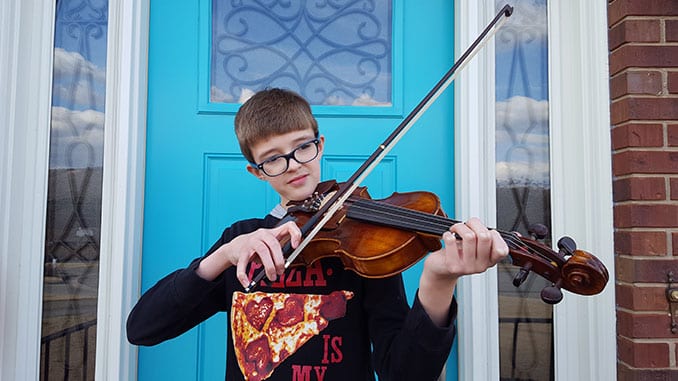
Marfan syndrome is a genetic condition that affects the body’s connective tissue, which is what holds the body’s cells, organs, and tissue together and helps the body grow properly.
Published: February 28, 2019
By: Paige Townley
Carter Trahan never really seemed sick. He was surprisingly tall, and he did have to get glasses at a young age, but his mother, Chanda, never suspected he might be showing signs of any potential problems. “It’s easy to shrug off a child having to get glasses when so many family members wear them already,” she says. “We thought nothing of it. Thankfully his pediatrician wanted to be safe and suggested we take a further look.”
Carter’s pediatrician sent him to a pediatric cardiologist to have his heart looked at, and while it looked fine, the cardiologist agreed that he should go on to UAB/Children’s of Alabama’s Marfan Syndrome and Related Disorders Clinic to be tested for Marfan syndrome. “It was a grueling several weeks waiting on the results to come back,” Trahan adds. “And when they did, it revealed he did have Marfan.”
Marfan syndrome is a genetic condition that affects the body’s connective tissue, which is what holds the body’s cells, organs, and tissue together and helps the body grow properly. Because connective tissue is found throughout the body, the syndrome can cause problems in various places, including the heart, eyes, joints, bones, and blood vessels. The lungs, skin, and nervous system can be affected as well. Some of the most common issues caused by Marfan syndrome causes are aortic enlargement, which can be life threatening, and eye problems, including severe nearsightedness, dislocated lens, and detached retina. “We’ve been very fortunate in that Carter hasn’t really had any problems,” says Trahan. “But we’re cautious and make sure he goes for checkups with his cardiologist and eye doctor. You just never know when something could change.”
The Marfan Foundation is hosting the 2019 Birmingham Walk for Victory Saturday, March 9 from noon until 3 pm at Railroad Park. For more information or to register, visit marfan.org/walkbirmingham19.
According to the Marfan Foundation, about one in 5,000 people have Marfan syndrome and about 200,000 people in the U.S. have the syndrome or a related condition. Typical visible features of Marfan syndrome are long arms, legs, and fingers, curved spine, flexible joints, flat feet, tall and thin body type, and the chest either sinks in or sticks out. Anyone with Marfan syndrome is born with it, but conditions aren’t always immediately present, so many people have it and don’t know it until problems arise.
“Marfan syndrome is so much more common than people realize,” says Dr. Nat Robin, a geneticist and co-director at the Marfan Clinic. “It’s also something that doesn’t always have obvious symptoms. That’s why early detection is so key. There are so many possible cardiac complications that you want to diagnose early to prevent a tragic event from ever occurring.”
Early detection is one of the many reasons that led Robin and a group of other doctors to start the clinic a few years ago. “There was a great need that we recognized in which a large number of patients were either being referred for evaluation for Marfan syndrome or another related condition,” explains Fallon Levine-Brewer, a genetic counselor at the clinic. “At that time, they would have to go from one specialist to another to get all of the evaluations done. We knew providing one place where they could see multiple providers and get a thorough and comprehensive consultation was really needed.”
The doctors at the Marfan Clinic strive to serve as a medical hub for patients who have – or think they may have – Marfan syndrome or some sort of related disorder. “There is hope that if we recognize patients early and treat them properly, we could slow down the process of watching the aorta get bigger with time,” says Dr. Walter Johnson, a pediatric cardiologist and clinic co-director. “Surgery isn’t a cure and medication isn’t a cure, but we think patients have a better chance of doing well if we find them early and watch them frequently.”
While no two patients are the same, many Marfan patients do end up having some sort of heart surgery. Under the best scenario, it’s a corrective surgery that prevents a major problem from ever occurring.
The Marfan Foundation, a nonprofit group founded in 1981, supports those with Marfan and their families, educates medical professionals and the public to be aware of the signs, and raises money to fund research. “When we first started, there was no social media or any way for patients to communicate, and they felt really alone,” says Maya Brown Zimmerman, a member of the Marfan Foundation board of directors and a Marfan syndrome patient.
The foundation has helped Amber Harbison, whose husband and daughter Libby both have Marfan syndrome. After the family moved back to Alabama after a brief time in Georgia, Harbison felt it important to become even more involved in the foundation, eventually being leader of the foundation’s Alabama community group. “I feel blessed that I get to talk to people just starting their journey because I remember how hard it was for me when we started our journey when Libby was diagnosed,” she says. “I appreciate the opportunity to help people walk through it and see it’s not always as scary as it seems and there are a lot of options.”
The foundation also has helped Libby through its various programs for kids, such as the annual kids camps. “As adults, we tend to focus more on sharing medical information and tackling the problems, but for our kids it’s very different,” she says. “For them it’s so much about building relationships with other kids who are facing similar issues. They have a bond. It’s amazing to see the kids supporting each other just like the adults.”
Paige Townley is a Birmingham-based freelance writer.
